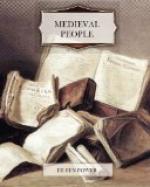3. On the cloth industry in general see G. Morris and L. Wood, The Golden Fleece (1922); E. Lipson, The Woollen Industry (1921); and W.J. Ashley, Introd. to English Economic History (1909 edit.). For the East Anglian woollen industry see especially the Victoria County Histories of Essex and Suffolk. For a charming account of another famous family of clothiers see B. McClenaghan, The Springs of Lavenham (Harrison, Ipswich, 1924).
B. Notes to the Text
1. Deloney’s Works, ed. F.O. Mann, p. 213.
2. Thomas Fuller, The Worthies of England (1622), p. 318.
3. A convenient introduction to the study of monumental brasses, with illustrations and a list of all the surviving brasses in England, arranged according to counties, is W. Macklin, Monumental Brasses (1913). See also H. Druitt, Costume on Brasses (1906). These books also give details as to the famous early writers on the subject, such as Weaver, Holman, and A.J. Dunkin.
4. Testamenta Eboracensia, a selection of wills from the Registry at York, ed. James Raine, 6 vols. (Surtees Soc., 1836-1902). The Surtees Society has also published several other collections of wills from Durham and elsewhere, relating to the northern counties. A large number of wills have been printed or abstracted. See, for instance, Wills and Inventories from the Registers of Bury St Edmunds, ed. S. Tymms (Camden Soc., 1850); Calendar of Wills Proved and Enrolled in the Court of Hastings, London, ed. R.R. Sharpe, 2 vols. (1889); The Fifty Earliest English Wills in the Court of Probate, London, ed. F.J. Furnivall (E.E.T.S., 1882); Lincoln Wills, ed. C.W. Foster (Lincoln Record Soc., 1914); and Somerset Medieval Wills, 1383-1558, ed. F.W. Weaver, 3 vols. (Somerset Record Soc., 1901-5).
5. The will of the other Thomas Paycocke ‘cloathemaker’, who died in 1580, also refers to the family business. He leaves twenty shillings ’to William Gyon my weaver’; also ’Item, I doe give seaven poundes tenne shillinges of Lawful money of Englande to and amongest thirtie of the poorest Journeymen of the Fullers occupacion in Coggeshall aforesaide, that is to every one of them fyve shillinges.’ William Gyon or Guyon was related to a very rich clothier, Thomas Guyon, baptized in 1592 and buried in 1664, who is said to have amassed L100,000 by the trade. Thomas Paycocke’s son-in-law Thomas Tyll also came of a family of clothiers, for in a certificate under date 1577 of wool bought by clothiers of Coggeshall during the past year there occur the names of Thomas Tyll, William Gyon, John Gooddaye (to whose family the first Thomas Paycocke left legacies), Robert Lytherland (who receives a considerable legacy under the will of the second Thomas), and Robert Jegon (who is mentioned incidentally in the will as having a house near the church and was father of the Bishop of Norwich of that name). See Power, The Paycockes of Coggeshall, pp. 33-4.




